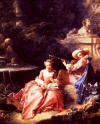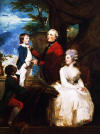|
Search:: Artists Alphabetically 100 Greatest Painters 50 Greatest Paintings Art Movements Rococo Art 1710-1750 About the Rococo Art Movement 'The Art of the Aristocracy' The word is derived from "rocaille" (pebble), but the term referred in particular to the small stones and shells used to adorn the interiors of grottoes. Such shells or shell forms were the primary motifs in Rococo ornament. The Rococo movement was initially restricted to France, later spreading to all of Europe and above all to England. The movement continued to develop until the arrival of Neoclassicism which attempted to return to the purism of classical antiquity. Rococo art themes centered around carefree aristocrats at play in make-believe settings. Cherubs were often included in the mix to give the work a touch of delightful whimsy. Romantic scenes depict luxuriously costumed ladies and gentlemen flirting, picnicking and playing music at gallant country parties. The background scenery is often a serene natural setting with delicate trees and sprays of roses. Colors are a profusion of soothing, light pastels. Famous Rocco painter, Joshua Reynolds stated "Raphael and Titian seem to have looked at Nature for different purposes; they both had the power of extending their view to the whole; but one looked only for the general effect as produced by form, the other as produced by colour." The Rococo style began as a backlash against Baroque formality and stuffiness. Unlike Baroque, Rococo is not concerned with religious matters or dramatic expression. The highly decorative art and design movement began in Paris, France in the early 1700s and is sometimes called the style of Louis XV (15th) . The style is profoundly symbolic of the hedonism of the European upper-classes. Rocco manner is characterized by graceful, enchanting, lighthearted themes of flirting and unrequited, melancholic love among the aristocracy. Sentiment was expressed over reason and emotionalism was expressed over intellect. Paintings are animated and clever, reflecting an impishly sensual daydream. Rococo Portraiture Rocco paintings feature beautiful aristocrats decked out in velvet, elegant laces and rich golden embroideries. The figures are tall and willowy, stylish and charming. The faces are presented as soft and rosy, effeminate and eternally young. Noblemen are depicted wearing feminine coiffeurs, rouged lips and cheeks, often sporting high heels. Family portraits are dreamy and light hearted. Servants are depicted happily serving their aristocratic employers and were often included in family portraits. The Rocco female figures are delicate and light; the faces, are childish and sentimental. The lines of the mouth curve in soft mischief or in a delicate enchanting smile. |
|
|
Key Descriptive Words and Phrases associated with the Rococo Movement - Late Baroque, tapestry, Charlottenburg Palace, Versailles, 18th century, France, colloquialism, Louis XV's reign, frills, powdered wigs, masks, whimsy, garish makeup, men in high heels, cherubs, elaborate recipes, pre-revolution, rediscovery of the classical world, Château de Chantilly, ethereal background scenery, melodramatic, decorative, Age of Discovery, axonometric drawing, curiosity about the natural world, pastel colors, romanticized landscapes, courtship Require more facts and information about Rococo Painting? Dig around every nook and cranny of the known universe for information this subject. Search Here Examples of Rococo painting click to enlarge © HistoryofPainters.com If you like this page and wish to share it, you are welcome to link to it, with our thanks. If you feel you have worthwhile information you would like to contribute we would love to hear from you. We collect essential biographical information and artist quotes from folks all over the globe and appreciate your participation. When submitting please, if possible, site the source and provide English translation. Email to millardmulch@gmail.com copyright 2011 - historyofpainters.com
|
|
The Art of Frivolity Key Painters of the Rocco Movement Pompeo BatoniBernardo Bellotto Francois Boucher Canaletto Jean-Baptiste Chardin Jean-Honoré Fragonard Thomas Gainsborough Francisco de Goya Thomas Hudson Jean-Marc Nattier Joshua Reynolds Paul Sandby Jean Antoine Watteau |


